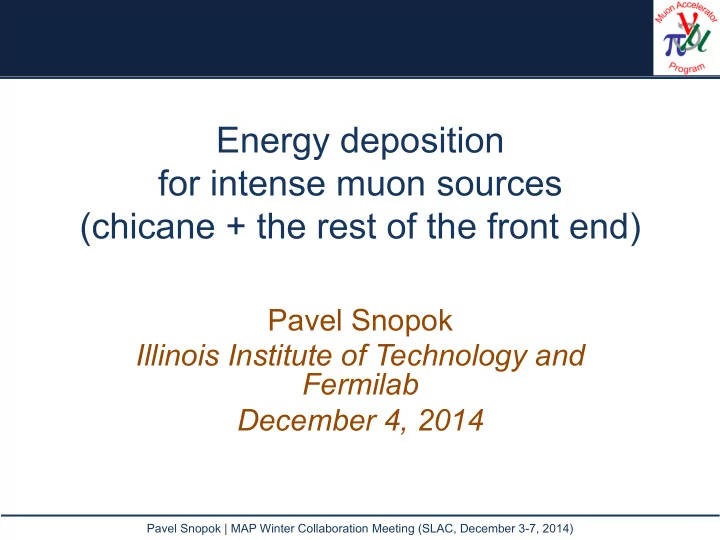

Energy deposition for intense muon sources (chicane + the rest of the front end) Pavel Snopok Illinois Institute of Technology and Fermilab December 4, 2014 Pavel Snopok | MAP Winter Collaboration Meeting (SLAC, December 3-7, 2014)
Outline • Introduction • History • Current MARS simulations – new data files for solid target • Using other codes (ICOOL and G4beamline) • Summary December 4, 2014 Pavel Snopok | MAP Winter Collaboration Meeting (SLAC, December 3-7, 2014) 2
Introduction 10 proton µ + and µ - Power deposited per unit length [kW/m] e + and e - 1 0.1 0.01 0 50 100 150 200 250 z [m] • In high-intensity sources muons are produced by firing high energy p onto a target to produce π . • π decay to µ which are captured and accelerated. • Significant background from p and ē , which may result in – heat deposition on superconducting materials; – activation of the machine preventing manual handling. December 4, 2014 Pavel Snopok | MAP Winter Collaboration Meeting (SLAC, December 3-7, 2014) 3
Introduction, contd. • Need a secondary particle handling system for a megawatt class solid C target – solenoidal chicane – followed by a proton absorber. • Challenges of optimization and integration of the system with the rest of the muon front end. • Main study tool – MARS, some analysis and validation by using ICOOL and G4beamline. • Start with the chicane, use the same technique downstream to study the the buncher and phase-rotator sections. December 4, 2014 Pavel Snopok | MAP Winter Collaboration Meeting (SLAC, December 3-7, 2014) 4
History: MARS simulations • ROOT-based geometry • 12.5° single bend, Z=0 corresponds to 19 m downstream of the target – consistent with RDR (IDS-NF). • W density reduced to 60% to take into account packing fraction for beads. 5
Reference: no shielding DPD peaks at 15.8 mW/g, that translates into 42.6 kW/m for Cu coils or 33.3 kW/m for SC coils. December 4, 2014 Pavel Snopok | MAP Winter Collaboration Meeting (SLAC, December 3-7, 2014) 6
Uniform 35 cm shielding Empty channel PD total, mW/g 7
Non-uniform 30 and 40 cm shielding Empty channel PD total, mW/g 8
Overall DPD per coil/segment Segmented coil analysis, total DPD, mW/g Average DPD per coil, mW/g In both cases red line corresponds to 0.1 mW/g SC limit 9
Current MARS simulations • New target parameters: – 8 GeV => 6.75 GeV – 4 MW => 1 MW – 3.125e15 protons/sec => 0.925e15 protons/sec – new particle distribution – need to re-run MARS • The hope is that the new parameters help reduce the amount of shielding required December 4, 2014 Pavel Snopok | MAP Winter Collaboration Meeting (SLAC, December 3-7, 2014) 10
New results Muon flux, top view Muon flux, side view 11
New results 2 Proton flux, top view Proton flux, side view 12
New results 3 Deposited power density, mW/g, Deposited power density, mW/g, top view side view 13
New results 4 Deposited power density, mW/g Deposited power density, mW/g segmented coil analysis averaged 14
Other codes • Can G4beamline or ICOOL be used for energy loss/ deposition calculations? • Back in 2010 I did a comparison of the two codes for IDR: ICOOL: proton 1 g4bl: proton 0.9 ICOOL: µ + and µ - Integrated losses per 8 GeV proton g4bl: µ + and µ - 0.8 ICOOL: π + and π - 0.7 g4bl: π + and π - ICOOL: e + and e - 0.6 g4bl: e + and e - 0.5 0.4 0.3 0.2 0.1 0 0 50 100 150 200 250 z [m] December 4, 2014 Pavel Snopok | MAP Winter Collaboration Meeting (SLAC, December 3-7, 2014) 15
Summary • Simulations of the new 1 MW graphite target are underway, first results presented. – power density > 0.1 mW/g only in a handful of cental coils, very low everywhere else; – definitely do not need 35 cm of tungsten. • Action item: implement a more sophisticated geometry (elliptical cross-section following the profile of the beam). – this will allow to significantly reduce the amount of W used for shielding. • MARS is the main tool, although G4beamline and ICOOL can also be used for some analyses. December 4, 2014 Pavel Snopok | MAP Winter Collaboration Meeting (SLAC, December 3-7, 2014) 16
Thank you! December 4, 2014 Pavel Snopok | MAP Winter Collaboration Meeting (SLAC, December 3-7, 2014) 17
Recommend
More recommend